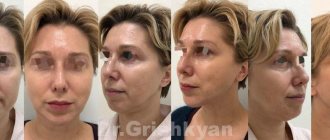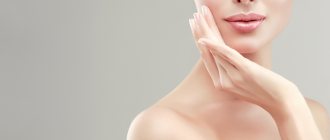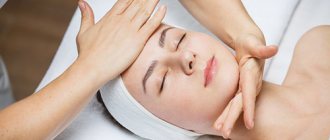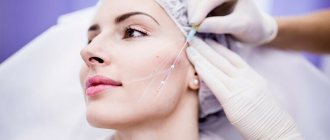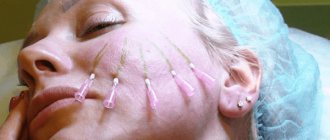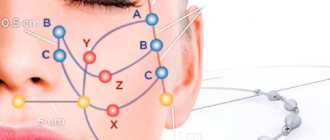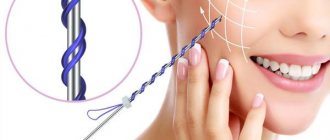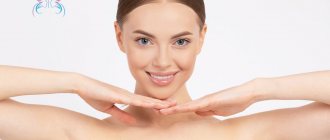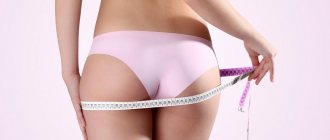Skin withering and sagging is a natural process. No matter how much we take care of our skin, over time it still loses its elasticity and radiance, becomes dry and flabby, and leads to loss of facial contours.
Modern medicine has techniques that help stop the aging process of the skin. For example, with the help of plastic surgery, you can tighten the shape of your face and lose 10-15 years. And with the help of cosmetic procedures, you can improve the condition of your skin. But, there are also cosmetic procedures that combine tightening and improving the condition of the skin at the same time.
In this article we will look at and compare two facelift procedures – reinforcement with Radiesse and threads.
Radiesse preparation
This is a filler consisting of 30% calcium hydroxyapatite and 70% distilled water. It is hypoallergenic and is completely eliminated from the body over time.
Radiesse is used for:
- facial contour correction;
- replenishment of lost volume of soft tissues on the face and body;
- eliminating wrinkles and creases on the face (except for the eyebrow fold, as necrosis is possible);
- smoothing scars;
- correction of the shape of the nose, cheekbones, cheeks, chin.
Benefits of Radiesse:
- the effect is noticeable immediately and lasts longer (up to 18 months) compared to fillers based on hyaluronic acid;
- production of natural collagen in the skin;
- visible lifting effect and restoration of contours;
- rapid smoothing of medium and deep wrinkles;
- after the procedure, the face/body part becomes much younger, and at the same time looks natural;
- safety of the drug.
- Contraindicated in the presence of foreign bodies, such as liquid silicone and other permanent implants.
View this post on Instagram
A post shared by Cosmetology Dr. Grishkyan (@grishkyan.clinic)
Threadlifting
This technique of introducing special threads into the subcutaneous layer, which can be either absorbable or non-absorbable. Absorbable sutures are more popular, with the most popular being sutures made from polydioxanone, a product treated with polylactic acid. They have a smooth, even surface and ridges that help provide better grip. Polydioxanone threads disintegrate in the body within a few months. After the breakdown, collagen and elastin fibers remain, and therefore the result lasts for another one and a half to two years. It also depends on the type of threads and their number.
Threadlifting has its own advantages:
- The threads are located in the subcutaneous fat layer. This allows you to more deeply form the facial frame and increase the density of the skin.
- Mesothreads are universal. With them you can perform lifting, reinforcement, as well as 3D modeling, which allows you to form three-dimensional structures under the skin that deeply smooth out all sorts of unevenness of the skin surface.
- The procedure is more controlled in contrast to other cosmetic procedures, such as, for example, the introduction of fillers.
- A great rejuvenating effect is achieved. Defects of the face and skin are not only corrected, but new structures are built, affecting the subcutaneous structures.
In connection with the above, we can say that thread lifting is an effective procedure that deserves attention. Threads, as mentioned above, are universal and allow you to deal with many age-related problems. Different types of threads are used for different problems. For example, when a patient has many small wrinkles in the skin, thick reinforcement with smooth threads is required. While in case of serious problems you should turn to lifting. Threadlifting should be carried out by a professional, only then can you be sure of the perfect result.
A method such as thread lifting is probably second only to plastic surgery, but it is not omnipotent. If wrinkles have already formed, then a facelift with mesothreads will only help reduce the degree of their manifestation. The same can be said about the situation when already formed wrinkles are observed. Many age-related problems arise due to loss of volume of subcutaneous tissue, and threads cannot restore this volume.
Threads for lifting
These are very thin, light, invisible threads made of natural material that dissolve over time. In place of the threads, a framework of connective tissue is formed.
Thread lifting is used for:
- formation of the oval face;
- reducing facial wrinkles and folds;
- improving the appearance of the skin, giving it tone, elasticity and firmness.
Effect of using threads:
- smooth skin and tightening of sagging areas;
- absence of fine and deep wrinkles;
- elimination of “crow’s feet” around the eyes and smoothing of nasolabial folds;
- fresh face without dark circles under the eyes;
- tightening the corners of the lips and eyebrows;
- increasing skin elasticity and turgor.
The work of clinic doctor Lydia Kogan. Aptos EV thread lift in combination with fillers. There are contraindications, specialist consultation is required
About mesothreads
Operating principle, features
A truly magical development by South Korean scientists has taken one of the leading places in the world of cosmetology. Mesothreads or the so-called “thread lifting” is, in fact, a non-surgical face lift. The procedure involves the subcutaneous introduction of mesothreads using the finest flexible needles made of high-quality steel. The main goal is to tighten the skin of the face, neck, chest, even the whole body.
Mesothreads are biological threads made from various materials. Depending on the type of action and rate of breakdown of the material in the human body, threads can be of several types:
- Smooth threads (linear, monofilament);
- With notches (mesothreads) – have the longest lasting effect;
- Surgical lifting options (spiral threads) - have shape memory - after subcutaneous injection they tend to return to the original shape, thereby enhancing the lifting effect.
Mesothreads also differ in the type of material used and can be absorbable, long-term absorbable, or non-absorbable. Absorbable mesothreads are the absolute favorite among the existing ones. This is what the term “thread lifting” refers to.
Important.
Threads for facial lifting are often made from polydioxanone, a synthetic material. But there are also other compositions, including those based on gold. If we talk about synthetic materials, they have neither pyrogenic (temperature-raising) nor antigenic properties. Therefore, mesothreads are considered absolutely hypoallergenic and do not cause significant tissue swelling.
How do mesothreads work? If we talk about polydioxanone, then its “vitality” is represented by 2 phases. The first is tissue lifting by creating a kind of mechanical frame, preserving the strength and structure of the threads. The duration of the stage is about 90-120 days. The second is a gradual loss of mass and strength of the threads. In place of the disintegrating threads, collagen is formed due to tissue biostimulation: the body’s production of hyaluronic acid is activated. The duration of the stage is 180-240 days.
After splitting the threads, a formed natural frame (bio-reinforcement) remains, which lasts up to 1.5-2 years after the procedure. The number of threads used in one procedure ranges from 5 to 50, depending on the severity of the problem and the desired effect.
How is the procedure done? Threadlifting involves inserting microneedles through punctures in the skin. Following the needle is a thread inserted to a certain depth. After which the needle is carefully withdrawn, and the thread remains fixed inside the tissue. The procedure is carried out exclusively under sterile conditions after treating the skin with an antiseptic and anesthetic.
Advantages of mesothreads
Although the thread lifting procedure is considered quite new in the cosmetology world, it has managed to gain momentum in popularity, not least due to its unique advantages:
- Safety of the composition - all mesothreads are hypoallergenic;
- Painlessness – thanks to the use of the finest microneedles and anesthetic, thread lifting is considered a procedure that does not cause discomfort;
- Versatility of use - with the help of mesothreads, not only lifting is possible, but also 3D modeling, reinforcement of various parts of the body;
- Fast recovery after the procedure – within a few hours after leaving the cosmetologist’s office, the skin will begin to recover;
- Quick and long-lasting results - within the first week the effect of the procedures is already noticeable, the maximum result appears after a couple of months and lasts up to 2 years.
Recovery after the procedure
The rehabilitation period after thread lifting, as a rule, does not exceed 5-7 days, subject to the recommendations of the cosmetologist. During this period, painful sensations on the skin are possible, traces of needle punctures are noticeable, and minor bruising is possible.
During recovery, visiting swimming pools, baths, and playing sports is not allowed. For at least one week, it is important to lead a measured lifestyle, remember about antiseptic skin care, and then rehabilitation will be comfortable.
Alternative to threads – Sculptra
Sculptra is a filler based on polylactic L-acid, which restores the volume of facial tissues by stimulating the production of its own collagen.
Sculptra is used in the following areas:
- cheeks;
- lower jaw and chin;
- auricle;
- nasolabial folds.
Advantages of the drug:
- acts in the deep layers of the skin, stimulating the natural production of collagen;
- replenishes the deficit in soft tissue volume in the lips, cheeks, cheekbones, and hands;
- restores skin structure and density;
- the result lasts from 25 months or more.
Complex application
Previously, contouring and threadlifting procedures were considered incompatible. It was believed that combination could lead to serious complications. Now it is quite possible to combine them, if only the fillers and threads are absorbable, that is, temporary. However, it is impossible to combine fillers with non-absorbable gold and platinum threads. If you try to combine absorbable fillers or threads with non-absorbable materials, this risks the appearance of inflammation, asymmetry on the face, allergic manifestations, etc.
Contour plastic with hyaluronic acid and traditional threads can be combined without problems. Fillers will help replenish the lost internal volume in the subcutaneous areas, and thread lifting will help cope with the problems of sagging facial contours, it will strengthen and tighten the facial skin. Contour plastic surgery cannot help change the shape of the face due to the fact that the gels are quite liquid. This is a significant drawback of the technique. And thread lifting cannot help fill the lost subcutaneous volume. This is a significant disadvantage of thread lifting. Knowing all the advantages and disadvantages of the presented methods, you can achieve an excellent result by combining and using them together to solve the complex problem of face lifting and filling the missing volume.
If you place mesothreads at the bottom of a wrinkle or fold, and after a certain time fill these skin depressions with filler, this increases the effectiveness of the technique and its effectiveness. In some cases, this can slow down the aging process in the affected area for 4-5 years. If you use only the traditional method of correcting the age-related problems under consideration, then the duration of the effect is only one and a half to two years.
Contour plastic and thread lifting cannot be opposed. Each of these cosmetic procedures has its own advantages and disadvantages, and the latter disappear when the above-mentioned anti-aging techniques are carried out correctly together. At the same time, only a cosmetologist should select one or another technique or complex effect. Because each case is individual. And in one case, filling with fillers is sufficient, but in another, an integrated approach is required.
Mesotherapy
Facial mesotherapy is the application of liquid from individually selected amino acids, vitamins and minerals that the body needs. The procedure improves skin microcirculation, blood circulation, and works with cell regeneration processes. The effect of mesotherapy occurs after about 3 weeks. The number of sessions depends on the problem of the skin, usually 6 procedures are enough.
Benefits of mesotherapy:
- Safety;
- Double chin lift;
- Reducing the number of acne, scars and stretch marks;
- Smoothing facial and other wrinkles;
- Restoration and treatment of hair and scalp;
- Elimination of swelling around the eyes.
Proper skin care after procedures will preserve the results for many years.
Contraindications to contour plastic surgery with Estefil filler:
- Presence of autoimmune diseases;
- Epilepsy;
- Viral or infectious diseases;
- Hypersensitivity or allergic reaction to the components of the drug;
- Hemophilia, a bleeding disorder;
- Inflammatory processes and/or permanent fillers at injection sites;
- Pregnancy or lactation period;
- Herpes is in the acute stage.
Indications
Implantation of mesothreads for face lifting is recommended in a number of cases:
- to eliminate wrinkles on the forehead, between the eyebrows, around the eyes, mouth, etc.;
- for straightening nasolabial folds;
- if necessary, correction of facial asymmetry;
- to restore skin elasticity;
- to improve the color and contour of the face;
- to eliminate age-related ptosis of the upper eyelids;
- for raising eyebrows, drooping corners of lips;
- in order to prevent age-related changes.
The best result is achieved when thread lifting is carried out at the first signs of aging. Depending on the type of threads used, the anti-aging effect can last up to two years. Many cosmetologists recommend mesothreads for people over 40 years old, even in the absence of pronounced age-related changes.
Injection biorevitalization
Injections are carried out by a qualified cosmetologist - using a special syringe with a needle, hyaluronic acid is injected under the skin. The method allows you to get instant results; the procedure itself lasts about 1 hour.
Biorevitalization makes facial skin more well-groomed, tightens folds, smoothes the oval of the face and noticeable wrinkles.
Advantages of biorevitalization:
- Safety;
- High efficiency;
- Use of a hypoallergenic natural humidifier;
- Preservation of the cosmetic effect for six months or longer;
- Lack of special training and long-term rehabilitation;
- Relatively low prices.
What do the procedures have in common?
Both procedures are beauty injections. The main component of the compositions injected under the skin—hyaluronic acid—combines bioreinforcement and biorevitalization. In addition, both options are aimed at rejuvenation and facelift.
Procedures for the introduction of hyaluronic acid are not always successful. Sometimes, due to sufficient production of your own collagen and the breakdown substance hyaluronidase, completely different processes are launched that stimulate the growth of wrinkles. Therefore, collagen injections should be administered only when there are indications for them.
Indications and contraindications for procedures
Both fillers and mesothreads have a number of common indications:
- Pronounced nasolabial folds;
- Folds behind/in front of the auricle;
- Ptosis of eyebrows, cheeks;
- Vertical and horizontal wrinkles;
- Folds on the chin and neck;
- Nasolacrimal groove;
- Uneven skin texture (although mesothreads will be a little more effective here), etc.
Separately, we can highlight the preference of thread lifting over fillers in a number of cases:
- Correction of age-related changes such as ptosis (drooping of the eyelid), deep horizontal wrinkles, nasolacrimal and nasolabial furrows, “crow’s feet” in clients aged 35 to 45 years;
- An auxiliary means of tightening the skin before inserting barbed threads (for patients over 35 years of age);
- Correction of facial wrinkles in areas of the face inaccessible to botulinum therapy.
Despite the safety and versatility of both procedures, there are a number of contraindications for their implementation:
- Blood diseases;
- Somatic pathologies;
- Hemophilia;
- Mental and neurological disorders;
- Autoimmune pathologies;
- Acute infectious conditions;
- Inflammation of the skin at injection sites;
- Coronary heart disease, etc.
